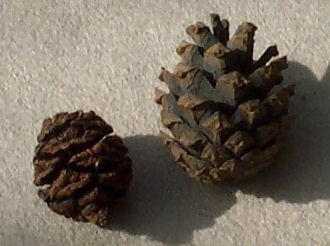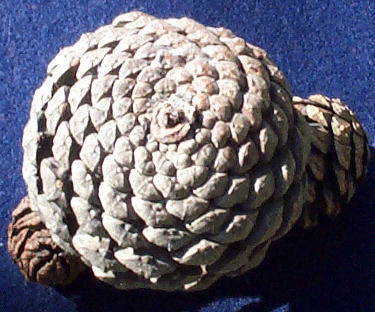 Fibonacci numbers and Golden ratio
Fibonacci numbers and Golden ratio 

 Fibonacci numbers and Golden ratio
Fibonacci numbers and Golden ratio 
Interesting numbers --- zero --- one --- complex --- root 2 --- golden ratio --- e --- pi --- googol --- infinity
Fibonacci, an Italian mathematician described the Fibonacci numbers in 1202 AD, although it had been described by Indian mathematicians earlier. The Fibonacci numbers are a sequence of numbers. You start with zero and one. Then the next number is the sum of the previous two. Zero plus one is one, the next number. One and one are two, the next number. One and two are three, two and three are five, three and five are thirteen, and so on. Click on the button to generate the series of Fibonacci numbers.
|
Pine cones can do mathematics! They are good at Fibonacci numbers. All cones grow in spirals, starting from the base where the stalk was, and going round and round the sides until they reach the top. There are two sets of spirals for each pine cone, going different directions. Here are two small pine cones. Click on the buttons to see the spirals. |  |
 |
The best place to count the spirals is at the base of the pine cone. The small cones above are rather hard to count, so here is a bigger one. Click on a button to watch the spirals being drawn. Count them to see which Fibonacci number it is. When you have drawn one set, you can move the mouse over the picture to make the spirals disappear. Move the mouse off to make them reappear. This helps you to see the spirals. You can remove the spirals and watch them being drawn again, if you wish. |
For all pine cones, the number of spirals in the two directions are next-door Fibonacci numbers. The smallest pine cone above has three spirals in one direction and five in the other. The medium one has five in one direction and eight in the other. And you can count the biggest one for yourself! (If you're interested, the smallest pine cone comes from a Giant Sequoia, the biggest tree in the world, although that one came from one not fully grown.) It's not just pine cones. Sunflower seeds grow in similar spirals, again in pairs of Fibonacci numbers. There is a reason for this. Fibonacci numbers are an approximation to an irrational number (see below) which means that the seeds will not line up with each other, which could weaken the flower head or pine cone.
|
We can draw our own spiral using Fibonacci numbers. Draw a rectangle with sides as a pair of Fibonacci numbers. Divide it into two parts, one being a square. The remaining rectangle also has sides of Fibonacci numbers. Divide that into two, one part being a square, and so on. The squares should be arranged so they spiral inwards. As you draw each square, also draw a quarter circle (going the right way!) Click on the button to see it happening.
| 
|
If you take a pair of next-door Fibonacci numbers and divide the bigger by
the smaller, you get an approximation to a number called the golden ratio. This
is an irrational number,  = (1 + √5) / 2. As the Fibonacci numbers get bigger, the approximation
gets closer. Keep clicking on the button to get these approximations. See the
way that the answers are more or less than the golden ratio alternately.
= (1 + √5) / 2. As the Fibonacci numbers get bigger, the approximation
gets closer. Keep clicking on the button to get these approximations. See the
way that the answers are more or less than the golden ratio alternately.
 (approx) =
(approx) =
You can only get a limited precision because there is a limit to accuracy on this computer. Here is a more accurate value, to 50 decimal places:
 = 1.61803 39887 49894 84820 45868
34365 63811 77203 09179 80576
= 1.61803 39887 49894 84820 45868
34365 63811 77203 09179 80576
If you draw a line of a certain length a, and divide it into two parts b and c where b is bigger than c, so that a / b = b / c, then that ratio is the golden ratio. If you draw a rectangle with sides in proportion to the golden ration, then this is called the golden rectangle. This has the property that if you remove a square from it, similarly to the spiral rectangle above, then the rectangle left also has its sides in proportion to the golden ration.
The golden rectangle is supposed to be a beautiful shape. Many artists and architects have deliberately used it in their work, while people have found the golden rectangle in many other works, even if it wasn't done deliberately. Here are a couple of examples.
Click here for another rectangle with interesting properties. |
 |
© Jo Edkins 2007 - Return to Numbers index